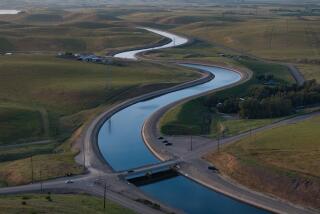Volunteers to help patrol new marine sanctuaries
Wardens won’t be the only people on patrol when new fishing restrictions take effect Jan. 1, setting up a network of state marine reserves on about 15% of the Southern California coast.
Environmentalists are deploying dozens of volunteers to keep an eye on the region’s new Marine Protected Areas through a coalition of programs called MPA Watch.
By boat, plane and from the shore, they will monitor fishing vessels, kayakers, divers and any other human activity in the new sanctuaries. And, in what is rankling fishermen, some of those monitors say they will confront suspected violators and report them to the state Department of Fish and Game.
The prospect of citizen patrols has drawn the anger of some anglers who are already irritated about losing access to lucrative fishing areas. Critics of the reserves, which are intended to allow depleted populations of fish to recover, have eyed MPA Watch with suspicion, saying that the environmental groups behind them are trying to take law enforcement into their own hands. One group of recreational fishermen crashed a training session in Malibu organized earlier this year by Heal the Bay, a nonprofit environmental group based in Santa Monica.
Heal the Bay and other conservation groups from Santa Barbara to Orange County say they will be another pair of eyes on the water, gathering data on all human uses of the coastline, not just fishing, to assess how behavior changes once the protections are in place.
Southern California’s array of 50 marine sanctuaries, approved by the state in 2010 after bitter negotiations between fishing and conservation groups, will cover more than 350 square miles of the state’s busiest waters, from Point Conception to the U.S.-Mexico border. They include kelp forests off Point Dume in Malibu and South La Jolla, Naples Reef and Campus Point in Santa Barbara County, a lengthy stretch of the Laguna Beach coastline and patchwork of habitat around the Channel Islands.
The sanctuaries are the third segment in a statewide chain that California is designating under the 1999 Marine Life Protection Act. Some are “no-take” reserves that are off-limits to anglers, while other conservation areas allow limited fishing. Setting aside an assortment of underwater canyons, kelp forests, sandy sea floors and rocky reefs is designed to help rockfish, cod, lobster, abalone and other sea creatures whose populations have declined despite catch limits and other regulations.
Among the biggest supporters of these aquatic reserves are the several dozen volunteers who have signed up with Santa Barbara Channelkeeper to walk the coast with binoculars and clipboards, noting every boat, surfboard, kayak, float tube and shore angler they see. Forty volunteers with Orange County Coastkeeper will help patrol and collect similar data from Dana Point to Huntington Beach.
In Los Angeles County, more than two dozen volunteers with Heal the Bay will conduct surveys from the shores of Zuma Beach and Abalone Cove. Several dozen others will mark down the coordinates and activities of vessels in the sanctuaries from aboard Santa Monica Baykeeper’s 24-foot motorboat. That’s in addition to the conservation group’s ongoing aerial surveys of fishing vessels along the Southern California coastline.
Though some groups such as Heal the Bay are not instructing volunteers to report suspected poachers, others plan to motor up to fishing boats that they find in the sanctuaries, confront them and contact authorities.
“We’re not trying to nab anyone. We’re trying to be friendly neighborhood environmentalists,” Brian Meux, marine programs manager for Santa Monica Baykeeper, said at a mid-December training session in a sanctuary area along Malibu’s Point Dume. “We’ll say: ‘If a warden sees you, you’re going to get a ticket, man.’ But if they’re just unfriendly and they keep fishing, we’re just going to call Fish and Game.”
Only a few dozen wardens patrol the entire Southern California coastline and the Channel Islands in three 54-foot offshore patrol vessels and about 10 smaller, shore-based boats. Supporters of the marine reserves worry that won’t be enough to ensure that the new rules are followed and marine life is protected.
Although the state Department of Fish and Game has widely publicized the new protected areas, releasing maps, coordinates and a mobile website, fishing groups say there is bound to be some confusion about the boundaries. Throwing third-party monitors into the mix could lead to altercations on the water, they say.
“If a private citizen with no authority comes up and tells fishermen not to do something, they may or may not believe the person is telling them the truth,” said Bob Fletcher, an advisor and past president of the Sportfishing Assn. of California, an industry group that opposes the sanctuaries that were adopted. “It may just create animosity between the environmentalists and fishing groups, who are going to be affected very negatively by these areas because they were really productive.”
Fish and Game officials stressed that only their officers can enforce the law. Still, the agency intends to act on information from environmental groups and from a poaching tip line described as “a confidential secret witness program.”
“We don’t have any illusion that we’re going to catch everybody,” said Paul Hamdorf, assistant chief of the agency’s law enforcement division, who oversees wardens in Southern California. “But if these groups are noticing a lot of violations every Saturday at a particular time and it would direct us how to best use our resources, then we might use it.”
Those found fishing in a closed area could face a warning and reminder about the restrictions, a ticket or arrest.
Scientists will be monitoring the areas too, trying to determine how effective they are at replenishing marine life.
University researchers, citizen-science volunteers, and even some lobster fishermen will be participating in studies in a variety of marine habitats. Some will count and measure key fish, invertebrates and algae in rocky reefs and kelp forests while others will tag and capture spiny lobsters to see if the restrictions have the intended “spillover” effect, increasing fish abundance outside the limits of the sanctuaries. One study will try to gauge how three sectors of the coastal economy — private recreation, commercial fishing and charter boat tourism — change once the reserves are in place.
More to Read
Start your day right
Sign up for Essential California for news, features and recommendations from the L.A. Times and beyond in your inbox six days a week.
You may occasionally receive promotional content from the Los Angeles Times.







